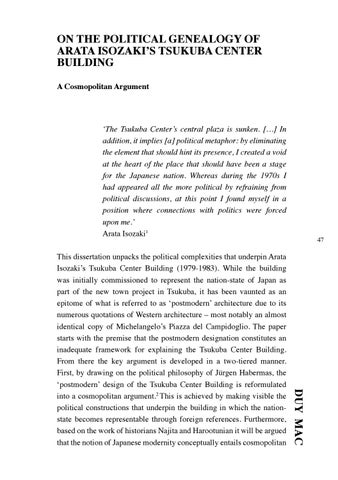ON THE POLITICAL GENEALOGY OF ARATA ISOZAKI’S TSUKUBA CENTER BUILDING A Cosmopolitan Argument
‘The Tsukuba Center’s central plaza is sunken. […] In addition, it implies [a] political metaphor: by eliminating the element that should hint its presence, I created a void at the heart of the place that should have been a stage for the Japanese nation. Whereas during the 1970s I had appeared all the more political by refraining from political discussions, at this point I found myself in a position where connections with politics were forced upon me.’ Arata Isozaki1
DUY MAC
This dissertation unpacks the political complexities that underpin Arata Isozaki’s Tsukuba Center Building (1979-1983). While the building was initially commissioned to represent the nation-state of Japan as part of the new town project in Tsukuba, it has been vaunted as an epitome of what is referred to as ‘postmodern’ architecture due to its numerous quotations of Western architecture – most notably an almost identical copy of Michelangelo’s Piazza del Campidoglio. The paper starts with the premise that the postmodern designation constitutes an inadequate framework for explaining the Tsukuba Center Building. From there the key argument is developed in a two-tiered manner. First, by drawing on the political philosophy of Jürgen Habermas, the ‘postmodern’ design of the Tsukuba Center Building is reformulated into a cosmopolitan argument.2 This is achieved by making visible the political constructions that underpin the building in which the nationstate becomes representable through foreign references. Furthermore, based on the work of historians Najita and Harootunian it will be argued that the notion of Japanese modernity conceptually entails cosmopolitan
47
